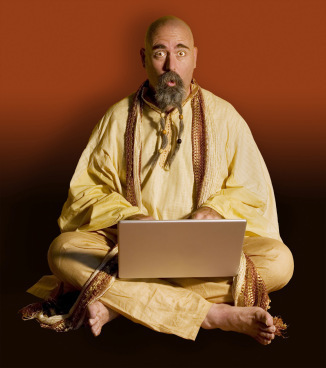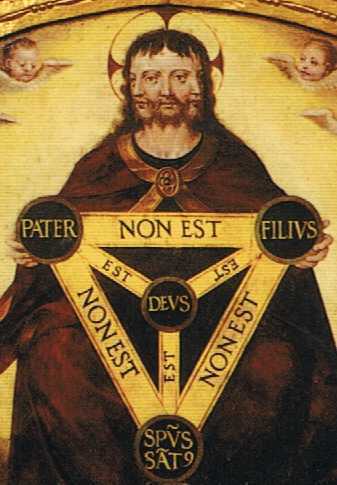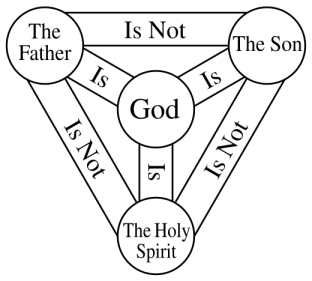Matt Fradd's Blog, page 59
April 16, 2014
Is Mary the Mother of God? A Socratic Dialogue
The following is a fictitious Socratic styled dialogue between John, a Protestant who rejects the doctrine of Mary, Mother of God (Theotokos) and Mark, a Catholic who (obviously) doesn’t. enjoy! Or don’t. Either way, let me know what you think.
John: Hey Mark, why do Catholics call Mary the “Mother of God.”
Mark: Uh, because she’s the Mother of God?
John: I disagree. Mary is a creature, she didn’t cause God.
Mark: It’s true she is not the source from which God came, and I of course agree that she is a mere creature, but Mary is the mother of Jesus, and Jesus is God, therefore Mary is the Mother of God.
John: Sorry, not buying it.
Mark: What? Logic and reason?
John: This seems to me to be nothing other than Catholic word-play to make Mary seem more special that she really is.
Mark: John, to whom did Mary give birth?
John: Jesus Christ, of course, as well as other children.
Mark: We can argue about the perpetual virginity of Mary at a later date, for now though you do believe that Mary gave birth to Jesus Christ.
John: I’m sorry is that a question? Of course I do, I just said that.
Mark: And who is Jesus Christ?
John: Okay, I’ll play along, he’s the savior of the world.
Mark: Fine, so Mary gave birth to the savior of the world. But who is this savior of the world? Who is Jesus?
John: God!
Mark: Bingo!
John: Who says bingo?
Mark: What would you have me say?
John: spot on?
Mark: I’m going to stick with bingo. So you agree that Mary gave birth to God and yet you refuse to call Mary the Mother of God?
John: Maybe she gave birth to his human nature but not his Divine nature.
Mark: Do Mothers give birth to nature’s or persons, John?
John: Okay, maybe she gave birth to Jesus’ human person but not his Divine person.
Mark: You’ve just demonstrated why the dogma of Theotokos is essential for understanding who Christ is. Christ is not more than one person, and Christ is not a human person; he is a Divine person.
John: Sure, okay, I see where you’re coming from. I guess I just think that it confuses people. People may end up thinking that Mary precedes God or something.
Mark: They might think that, but they would be wrong. Would you agree that just because something is confusing or ultimately incomprehensible it doesn’t follow that it is therefore false?
John: I’m confused.
Mark: But that doesn’t mean that what I’m saying is false, right?
John: My head hurts.
Mark: Mine too! But let’s press on. Would you agree that the doctrine of the Blessed Trinity is a confusing doctrine for many people? Would you agree that many Muslims, for example, when they hear of the Trinity think that we are Polytheists? That we worship three Gods?
John: Yes, I’d agree with that.
Mark: But just because the Trinity can be a confusing doctrine to explain, that doesn’t mean that it’s false, or that we should stop teaching it because it can cause confusion. The same is true with this doctrine, a doctrine which the Church has consistently held for over 2000 years. Listen to the words of John Cassian (c. 360 – c.435) who was writing against a man by the name of Nestorius, a man who committed the same error you’re committing in refusing to acknowledge that Blessed Mary was and is the Mother of God.
And so you say, O heretic, whoever you may be, who deny that God was born of the Virgin, that Mary the Mother of our Lord Jesus Christ ought not to be called Theotokos, i.e., Mother of God, but Christotokos, i.e., only the Mother of Christ, not of God.
For no one, you say, brings forth what is anterior in time. And of this utterly foolish argument whereby you think that the birth of God can be understood by carnal minds, and fancy that the mystery of His Majesty can be accounted for by human reasoning, we will, if God permits, say something later on. In the meanwhile we will now prove by Divine testimonies that Christ is God, and that Mary is the Mother of God.
John: Wow, your logic is irrefutable; I’ve completely changed my mind.
Mark: Really?
John: No.
Mark: Ah, I see what you did there.
April 14, 2014
Help Me Launch ThePornEffect.com
In order to get theporneffect.com up and supported we need to raise 15k Whaaaaa? You heard (read) me. Water’s free; whiskey costs money! Check out my go-fund-me site.
Please help me out by praying, sharing, and donating www.gofundme.com/mattfradd
April 11, 2014
Giving Away 40 Books in 24 hours!
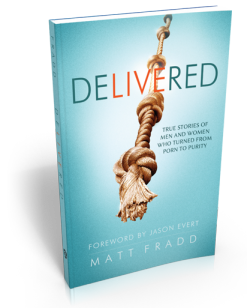 A man by the name of Shaun Alexander McAfee recently got in touch with me. He told me wanted to get Delivered into more hands.
A man by the name of Shaun Alexander McAfee recently got in touch with me. He told me wanted to get Delivered into more hands.
He offered to buy two boxes (20 per box) and asked that I run a competition here on my blog and have two winners win a box each.
This will be a quick competition, it’ll be over in 24 hours; 2pm (ET) tomorrow. Here’s how you enter. Tell us in one paragraph what good you could (and would) do with 20 copies of Delivered.
Check out Shaun’s review of Delivered.
April 5, 2014
Why Struggling With Porn Is A Good Thing
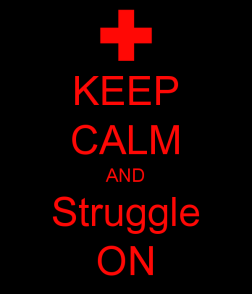
Struggling with porn can be an effective means of growing in virtue.
Whenever I’m interviewed on the topic of pornography, my interviewer usually begins by reminding the audience of what a ginormous problem pornography is. He then lists some (questionable) statistics on the size of the industry; recounts how this many men and that many women are addicted to it, and essentially, how the entire culture is going to hell in a hand basket.
Now all of this, I think, is true (My friend, Patrick Coffin, often asks, “Where are we going and why are we in this basket?”), but It’s also true that our Lord Jesus Christ has said, “take courage; I have conquered the world!” (Jn. 16:33).
As we battle the culture of death, we cannot forget this.
Struggling with porn can = growth in holiness
In today’s post, I’d like to remind us (or perhaps inform you) that struggling with pornography can be a beautiful and productive means of becoming holy, of becoming a saint.
Defining ‘Struggle’
Many Christians I encounter, seem to think that the word “struggle” is synonymous with “give into.” We hear people say, “I’ve been struggling with porn,” and we assume they mean “I’ve been giving into porn,” and that’s what they do mean. But struggle doesn’t mean “give into,” in fact, it means the opposite. This is how the dictionary defines struggle: “to contend with an adversary or opposing force.” [1]
Since this is the definition of struggle, if you are tempted to view pornography, I hope you struggle with porn!
Growth In Virtue
When we struggle, when we “contend with an adversary or opposing force,” we grow stronger. This is true with our struggle with pornography. When we struggle with pornography we grow in virtue. But it’s not just the virtue of purity we grow in, but many others besides. Let’s look at five in no particular order:
1. Patience
Though pornography offers a quick fix to our momentary affliction or pain, by struggling with it, we grow in the virtue of patience; we learn to endure hardship manfully.
2. Self-mastery
The man who struggles with pornography gains mastery over himself. As the Catechism puts it, “Chastity includes an apprenticeship in self-mastery which is a training in human freedom. The alternative is clear: either man governs his passions and finds peace, or he lets himself be dominated by them and becomes unhappy.” [2]
3. Humility
Struggling with pornography is a constant reminder of how weak, and of how in need of him, we are. St. Paul spoke about having a “thorn in the flesh,” though it’s unclear what this thorn represented, he tells us that it was to keep him humble: “To keep me from being too elated a thorn was given me in the flesh, a messenger of Satan to torment me, to keep me from being too elated” (2 Cor. 12:7).
4. Courage
Courage does not mean that one is not afraid (if one were not afraid, courage would not be required), rather it means choosing to do what is right in spite of fear, or pain, or uncertainty. And indeed, standing up against one’s own fallen desires, when (what feels like) the entire world is telling you to give in, takes courage!
5. Temperance:
“Temperance is the moral virtue that moderates the attraction of pleasures and provides balance in the use of created goods.”
If a man or woman is struggling with pornography, then he is certainly growing in this virtue. And if he can learn to say no to sexual sin, then he’ll certainly become stronger in saying no to less tempting pleasures, legitimate or not. “[Temperence] ensures the will’s mastery over instincts and keeps desires within the limits of what is honorable.” [3]
A More Interesting Person
So there you have it. Struggling with pornography can be a beautiful and effective means of growing in sanctity, which is another way of saying, becoming a more well-rounded and interesting person.
So struggle on brothers and sisters, and remind yourselves often of our Blessed Lord’s words: “take courage; I have conquered the world!” (Jn. 16:33).
Join The Conversation
What others virtues does struggling with porn cultivate?
March 26, 2014
How To Tell Your Fiance You Struggle With Porn
I get many emails from men asking my advice on how to break the news to their girlfriend/finance about their struggles with porn.
This short blog will be a summation of my thoughts, how I typically respond to such a question.
Should I Even Tell Her?
Let’s get this one out of the way first. Sometimes people will say (and if I’m honest, I remember thinking the same thing) 1) ‘do I even need to tell her at all?’; 2) ‘Is it any of her business?’; or 3) ‘I’m not sure that telling her will necessarily help me stay clean.’
My response? 1) ‘No’; 2) ‘If you’re discerning marriage with this girl, yes!’; and 3) ‘that’s not the point.’
No she doesn’t need to know, but it is her business. She’s discerning marriage with you, and therefore, it seems to me, she has a right to know (think of it as truth in advertising). The reason you need to tell her isn’t because it will motivate you to “stay clean,” it’s because she has a right to know the truth about the person she’s discerning marrying.
How Do I tell her?
I would suggest writing a letter. One major advantage of this is that you’re not expecting her to process all of this in front of you on the spot . The other advantage is it allows you to convey and complete your honest thoughts without reacting or being interrupted.
If you do decide to speak to her directly, try your best not to catch her off guard, tell her that you have some important things you need to discuss and then arrange a time and place to meet where you won’t be distracted.
What Should I Tell Her?
Begin by being broad yet specific. You might say, “I was first introduced to pornography at the age of eight. I need you to know that despite my efforts to be free of pornography, I fall to it about once a week/once a month/once every other month.” End the letter (or conversation) with something like the following, “I understand that in sharing this with you, you may very likely break up with me, while that’s the last thing in the world I want to happen, it’s a risk I needed to take because you deserve to know the truth.
Okay, that might be a way to begin and close the letter, but what else can be said?
Tell her what you have done and what you are doing to rid yourself of this sin and become a better man. Show her how you are fighting for her. Be creative! As St. Josemaria Escriva noted, ”[t]o defend his purity, Saint Francis of Assisi rolled in the snow, Saint Benedict threw himself into a thornbush, Saint Bernard plunged into an icy pond . . . You . . . what have you done?”
No, I don’t recommend taking your beloved to the botanical gardens and saying, “Honey, you see that rose bush?…Check this out!”
Here are some ideas:
- Install accountability software of your computer, phone, and tablet.
- Choose an accountability partner who you check in with on a regular basis.
- Ditch your fancy smart phone for an old-school one that cannot access the internet. Alternatively, have your accountability partner block your app store and delete all apps that can access the internet that aren’t being monitored by accountability software.
- Commit to a holy hour once a week, or praying the holy rosary once a day (or whatever, just commit to praying).
- Sign up to e5men.org, an online community of men who fast at least once a month for the women in their lives.
Focusing on what you’re doing for love of her rather than on the ways you feel like a big fat loser, is, I think, a much more manly approach when sharing your struggles with your beloved.
What Now?
Obviously much more could be said. In a future post I’ll address your girlfriend and whether or not she should stay with you. For now, if you or someone you love struggles with porn, learn the steps to be free.
March 25, 2014
Overcoming Porn: Why Spiritual Advice Isn’t Enough
In this post I’d like to address what I consider to be a problematic approach that Christians sometimes take when counseling those addicted to pornography.
It’s the nothing-but-spiritual-advice approach.
This approach is problematic for two reasons. 1) It fails to understand the nature of addiction, and 2) It doesn’t work (unless you’re Kirk Cameron in Fireproof—and you’re not).
Defning Terms
What do I mean by the nothing-but-spiritual-advice approach? I mean advice such as the following:
“You need to be praying a rosary every day.”
“Have you thought about becoming a daily communicant?”
“In Ephesians, St. Paul says that the sword we must use to ‘stand against the wiles of the Devil’ is the word of God. Are you spending time in the word each and every day?”
“St. Teresa of Avila says that there is nothing like Holy Water to put demons to flight; are you using holy water?”
The problem with this advice isn’t that it’s bad advice; it’s fine advice! It becomes problematic, however, when this is all that is offered. The nothing-but-spiritual-advice approach demonstrates ignorance concerning the nature of addiction (not that all porn users are addicted, but many are) and its impacts on the brain.
This Is Your Brain on Porn
The fact is that many neuroscientists are now explaining in scientific language what those of us who have been addicted to anything already knew: The addictive state leaves us in constant craving for a neurochemical cocktail (endorphins, dopamine, serotonin, etc.) that, with compulsive use, effectively re-sets the pleasure thermostat of our brain. The result is that alcoholics need more booze, drug addicts need bigger hits, and porn users need ever more intense kinds of sexual stimulation—just to feel “normal.” (Learn more here).
More is Needed
Once you realize that pornography has this deleterious effect on the brain, you see why the nothing-but-spiritual-adivce approach 1) fails to understand the nature of addiction, and 2) therefore won’t work.
Look, surely if you encountered a severely depressed person you wouldn’t offer nothing-but-spiritual-advice; you would, or should, I think, offer spiritual advice, but you would also say something like, “are you seeing anyone about this?” or “I’m not an expert but maybe there is a chemical imbalance. Do you think drugs might be necessary?” Similar questions could be asked of the porn addict.
Why It’s Offered, Why It’s Received
So that’s why I think this sort of advice is so often offered (“often offered.” Say that ten times fast!); many people (priests included) are simply ignorant of the neurological consequences of porn addiction. The reason I think that it’s so readily received without question is that Christians can feel guilty questioning the nothing-but-spiritual-advice approach. They rightly believe that, they “can do all things in [Christ] who strengthens [them]” (Phil. 4:13), and that ”nothing will be impossible with God” (Lk. 1:37).
But these two verses (plus the many more you can think of) do not mean that we give nothing-but-spiritual-advice to a cancer patient, or nothing-but-spiritual-advice to a drug addict. No, in fact if we cared for that person we would point them to competent specialists who can aid them in recovery—the same is true with porn addiction.
Spiritual advice is necessary, and that’s why in my five-step battle plan I offer it as my first step, but more is needed. Here are five steps that, in my opinion, are essential to anyone who hopes to be free of pornography.
March 22, 2014
Stephen Colbert Mocks Atheists
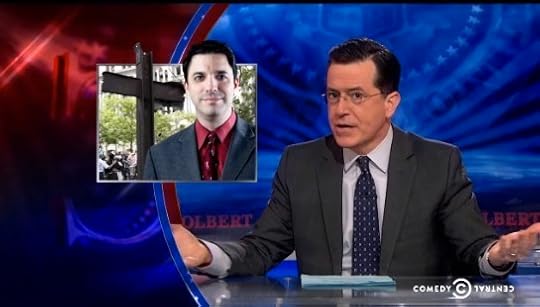
Last night, Stephen Colbert tackled American Atheists’ lawsuit against the National September 11 Memorial and Museum and its exhibit featuring a cross, a cross which some atheists claim causes “mental anguish”.
I thought he did a splendid job at mocking the stupidity of some (not all) of our fellow atheists.
Take a look and share your thoughts below.
The Colbert Report
Get More: Colbert Report Full Episodes,Video Archive
March 19, 2014
My Favorite St. Joseph Quotes
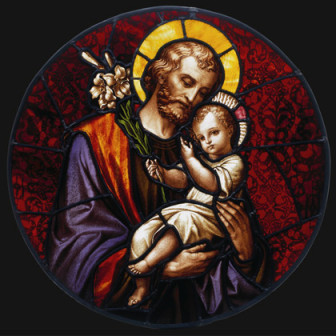
In honor of the feast of St. Joseph, I thought I would compile a list of my favorite quotes from him in the Bible:
March 14, 2014
How To Explain (and Not Explain) The Trinity
This essay was originally published in Catholic Answers Magazine
The mystery of the Most Holy Trinity is the “central mystery of [our] faith” (Catechism of the Catholic Church 234). It is therefore the most fundamental. If we get it wrong, then everything else gets obscured or perverted.
The Catechism summarizes the Trinity in this way:
We do not confess three Gods but one God in three persons, the “consubstantial Trinity.” The divine persons do not share the one divinity among themselves but each of them is God whole and entire. . . . In the words of the Fourth Lateran Council (1215), “Each of the persons is that supreme reality, viz., the divine substance, essence or nature” (CCC 253).
While this description is succinct and precise, it can be overwhelming for laypeople who are not used to technical terms such as consubstantial or essence. They might resort to one of the following inferior ways of sharing the truth of the Holy Trinity that we should all work hard to avoid.
1. “It’s a mystery. Stop trying to understand and just believe.”
When they are pressed with tough questions about how God can be three persons or how each member of the Trinity can fully be God, some Christians resort to an unfortunate tactic. They throw up their hands and say, “It’s a mystery!” They don’t bother to explain any of the tough questions, and sometimes they accuse people of lacking humility when those people try to accurately describe the Trinity. Isn’t trying to define the nature of the infinite and unique Trinitarian God an impossible task? Aren’t we trying to “drink up the ocean in a tea cup” by trying to fit God inside of our tiny, finite minds?
A mystery, it has been said, is not something that is unknowable; it is something that is incomprehensible. I know that pi is the ratio of a circle’s diameter to its circumference, but I don’t comprehend, and can never comprehend, the full value of pi, since it possesses an infinite amount of numbers after its decimal point. Likewise, I can know God is all-knowing, but I can’t fully comprehend what it’s like to be all-knowing.
The Church teaches that the mysteries of our faith, unlike the value of pi, are those things human beings cannot come to know through reason alone (CCC 237). In that sense the mysteries of the faith are not like the “mystery” of the Bermuda triangle or the “mystery” of the value of pi, both of which merely represent a gap in human knowledge that can be filled with diligent research. The mysteries of faith must be revealed to mankind in order for us to know them.
The First Vatican Council taught that while man can, by reason alone, come to know God exists, man cannot know that God is a Trinity of three persons or that the Eucharist is the substance of Christ’s body under the form of bread and wine. If God had not revealed these truths to mankind, we would still be in ignorance of them, which is why they are sacred mysteries of the Faith.
Also, just because we cannot fully understand something doesn’t mean that we cannot understand errors about that thing. For example, Jesus Christ is the most mysterious person who ever lived, because he was fully God and fully man (just try fully understanding what that’s like!). The Catechism even admits, “Many things about Jesus of interest to human curiosity do not figure in the Gospels. Almost nothing is said about his hidden life at Nazareth, and even a great part of his public life is not recounted” (CCC 514).
Simply put, there is a lot about Jesus of Nazareth that is mysterious, and we can’t presume to know more (such as what Jesus looked like) than what has been revealed for us. But correcting someone who says that Jesus was a woman, or that Jesus wasn’t a Jew, does not reveal a lack of humility; it reveals a sense of fidelity to those truths about Jesus we can know through historical investigation or by what the Church has revealed to us.
Since the Trinity is the most fundamental and essential teaching in the “hierarchy of the truths of faith” (CCC 90), we ought to stamp out errors wherever we find them. Unfortunately, these errors usually come about when Catholics with good intentions try to create an analogy to help nonbelievers, or those who need catechesis, to understand the Trinity.
The problem with using analogies to explain the Trinity is that God is the most unique being in existence. In fact, many theologians will tell you it’s not quite correct to call God a being but rather he is the being, or the reason anything exists at all. Because God is so unique, any analogy we use will inevitably fall short. The Catechism states, “God transcends all creatures. . . . Our human words always fall short of the mystery of God” (CCC 42).
While these analogies can be helpful for children, when they are pressed too far they lead to conclusions the Church has deemed heretical.
2. “The Trinity is like how a man can be a Son, a Father, and an uncle at the same time. He’s one and three at the same time, just as God is Father, Son, and Holy Spirit at the same time.”
Nope. This analogy commits the heresy of modalism. Modalism is the false belief that God is one person who has revealed himself in three forms or modes. Modalism is also called Sabellianism after Sabellius, an ancient theologian whom Pope Callixtus I excommunicated in A.D. 220.
Modalists were heavily influenced by Greek philosophy, which taught that God was an ultimate one, or act of unity. While this was a big improvement over Greek polytheism that posited a pantheon of gods who fought each other, it goes too far when it denies that God can be three relationally distinct persons in one being.
Returning to the bad analogy that leads to modalism, though a man may be a son, father, and uncle, he is not three persons as God is but one person who has three titles.
Another popular but false analogy is the following: The Trinity is like how water can be ice, liquid, and steam. This again commits the heresy of modalism. God does not go through three different states. The Persons of the Holy Trinity coexist; the different forms water may take cannot. Water cannot be ice, liquid, and steam at the same time. It may be between two stages such as when ice is melting, but this isn’t coexisting, it’s transforming.
Another analogy—attributed to Sabellius—that lives on today is that of the sun. The Father is the sun, while the Son and Holy Spirit are the light and heat created by the Father. But this analogy also smacks of modalism, because the star is simply present under different forms.
Or it can be seen to express Arianism, which is the heretical view that the Father is superior to the Son and Holy Spirit by being a different and “higher” divine substance than the latter two. In the sun analogy, the light and heat are passive byproducts of the sun and are not true equals in the way that the Father, Son, and Holy Spirit share equally and completely in the divine nature.
Another heretical byproduct of sabellianism is patripassianism (try saying that three times fast!): God exists as one “mode” and merely puts on the mask or role of “Father,” “Son,” and “Holy Spirit.” But this would mean that when the Son suffered on the cross, the Father also suffered on the cross (though he was wearing the mask or mode of being the son).
In William Young’s popular novel “The Shack,” the Trinity is illustrated through three people. The Father is an African-American woman named “Papa,” the Son is a Middle Eastern carpenter, and the Holy Spirit is a mysterious Asian woman. At one point Papa says to the main character that at the crucifixion “he and Jesus were there together,” and Papa even has scars just like Jesus (pp. 95-96). However, the Church teaches that God is impassible and that nothing human beings do can cause God to literally suffer like us. Jesus was capable of suffering on the cross only because he assumed a human nature and possessed a human body.
Basically, the main problem with modalism is that it denies that God is three distinct persons. The Catechism states, “’Father,’ ‘Son,’ ‘Holy Spirit’ are not simply names designating modalities of the divine being, for they are really distinct from one another”(CCC 254). What you are left with is a confusing monotheism where God merely pretends to be three different persons instead of actually being three different persons. Unfortunately, in order to correct this error some analogies overcompensate. This leads to our next bad analogy.
3. “The Trinity is like an egg: yoke, albumen, and shell. The three elements form one egg just as the three members of the Trinity comprise one God.”
This commits (or could at least lead one to believe it commits) the heresy of saying God is composed of three parts and that those parts make up one God. But God has no parts, as the late-second-century Church Father Irenaeus affirmed: “[God] is simple, not composed of parts, without structure, altogether like and equal to himself alone. He is all mind, all spirit, all thought, all intelligence, all reason . . . all light, all fountain of every good, and this is the manner in which the religious and the pious are accustomed to speak of God” (Against Heresies 2:13:3 [A.D. 189]).
The key here is understanding that we don’t believe in three persons who when united become God but in three persons who possess the same divine nature. ”The Father is that which the Son is, the Son that which the Father is, the Father and the Son that which the Holy Spirit is, i.e., by nature one God” (Council of Toledo XI (675): DS 530:26).
Three good ways to explain the Holy Trinity
Though it can be tempting to use an analogy to help our children understand who God is, in my experience with youngsters, analogies almost always muddy the waters. And since it’s better that our children not fully understand who God is than have a false understanding of him, I tend to stay away from them. The closest I get to “dumbing it down” for my kids is by 1) a simple conversation about being, person, and nature; 2) a simple diagram; and 3) the Athanasian Creed.
1. A Conversation on Being, Person, and Nature
First, here’s how I start the conversation with my one of my children.
Me: Liam, what is a person?
Liam: I dunno.
Me: A person is someone who can potentially say “I.” Is a statue a person?
Liam: No.
Me: Why?
Liam: Because it can’t say anything. It’s not alive.
Me: But a statue, like the one in the front yard, is real, right? It’s not make-believe like a dragon.
Liam: Of course.
Me: So anything that’s real is a being. So there are some beings, like statues, which are not persons, right?
Liam: Right.
Me: What about you, are you a person?
Liam: Yes.
Me: Okay. So a statue is a being with zero persons. You are a being who is one person. God is a being who is three persons. Make sense?
Liam: Not really.
Me: Good.
Since my son is only five years old, I’m happy I can at least get him to the foot of this theological mountain before he tries for the summit when he’s a little older. I’d rather have that than have him jump off a theological cliff by embracing a mistaken view of the Holy Trinity.
The key terms
Just remember that when you have conversations about the Trinity, the most important distinction you can make is between beings, persons, and natures. A being is a unified substance that exists. A person is an “I,” or individual self. Think of God as one being that is composed of three “I’s” or three persons, each of whom is fully God. The famous “Trinity shield” pictured above can help illustrate this concept. Frank Sheed wrote:
The newcomer to this sort of thinking must be prepared to work hard here. It is a decisive stage of our advance into theology to get some grasp of the meaning of nature and the meaning of person. Fortunately, the first stage of our search goes easily enough. We begin with ourselves. Such a phrase as “my nature” suggests that there is a person, I, who possesses a nature. The person could not exist without his nature, but there is some distinction all the same; for it is the person who possesses the nature and not the other way round.
One distinction we see instantly. Nature answers the question of what we are; person answers the question of who we are. Every being has a nature; of every being we may properly ask, “What is it?” But not every being is a person: only rational beings are persons. We could not properly ask of a stone or a potato or an oyster, “Who is it?” (Theology and Sanity, p. 92).
A Simple Diagram
When we examine the Trinity, we can ask of the Father, Son, and Holy Spirit who they are. The Father is the creator, the Son is the redeemer, and the Holy Spirit is the sanctifier. The Church teaches that the Son was eternally begotten by the Father. The Father has always been the Father and the Son has always been the Son. The Holy Spirit proceeds from both the father and the Son. Though they differ in their roles, it does not follow that the members of the Trinity differ in what they are. When we ask what the Father, Son, and Holy Spirit are, the answer is always the same. The Father is God. The Son is God. The Holy Spirit is God. Not a god. Each is God.
Critics may say God can’t be three Gods, and they are right. But if there can be beings composed of zero persons, and beings composed of one person, why can’t there be a being composed of three persons? To say God can’t be more than one person is to put a human limit upon divine omnipotence. If God is all-powerful, there is no reason he can’t enter into his creation or exist as the perfect cooperation of three equally divine persons.
Also, if God is love (1 John 4:8, 16) then love does not exist in a vacuum. Love involves fully giving oneself to the beloved. If God existed as love for all eternity, then there must have been someone to receive his love. Otherwise, God’s love would be imperfect, because it would not be willing the good of another person.
Furthermore, just as the love of husband and wife creates a new person, the eternal love shared between the Father and Son is itself an eternal person—the Holy Spirit, who enlivens the hearts of believers to understand the mystery of God’s love and share it with the rest of the world.
The Athanasian Creed
Perhaps the most eloquent statement of the Trinity I have ever read is the Athanasian Creed. It comes from St. Athanasius, that mighty defender of orthodoxy who stood against the heretic Arius when he denied that Jesus was fully God and that the Trinity was composed of equal members.
The entire creed comprises forty-four statements. Here are those related to the Trinity.
3. And the Catholic faith is this: That we worship one God in Trinity, and Trinity in Unity;
4. Neither confounding the persons nor dividing the substance.
5. For there is one person of the Father, another of the Son, and another of the Holy Spirit.
6. But the Godhead of the Father, of the Son, and of the Holy Spirit is all one, the glory equal, the majesty coeternal.
7. Such as the Father is, such is the Son, and such is the Holy Spirit.
8. The Father uncreated, the Son uncreated, and the Holy Spirit uncreated.
9. The Father incomprehensible, the Son incomprehensible, and the Holy Spirit incomprehensible.
10. The Father eternal, the Son eternal, and the Holy Spirit eternal.
11. And yet they are not three eternals but one eternal.
12. As also there are not three uncreated nor three incomprehensible, but one uncreated and one incomprehensible.
13. So likewise the Father is almighty, the Son almighty, and the Holy Spirit almighty.
14. And yet they are not three almighties, but one almighty.
15. So the Father is God, the Son is God, and the Holy Spirit is God;
16. And yet they are not three Gods, but one God.
17. So likewise the Father is Lord, the Son Lord, and the Holy Spirit Lord;
18. And yet they are not three Lords but one Lord.
19. For like as we are compelled by the Christian verity to acknowledge every Person by himself to be God and Lord;
20. So are we forbidden by the Catholic religion to say; There are three Gods or three Lords.
21. The Father is made of none, neither created nor begotten.
22. The Son is of the Father alone; not made nor created, but begotten.
23. The Holy Spirit is of the Father and of the Son; neither made, nor created, nor begotten, but proceeding.
24. So there is one Father, not three Fathers; one Son, not three Sons; one Holy Spirit, not three Holy Spirits.
25. And in this Trinity none is afore or after another; none is greater or less than another.
26. But the whole three persons are coeternal, and coequal.
27. So that in all things, as aforesaid, the Unity in Trinity and the Trinity in Unity is to be worshipped.
28. He therefore that will be saved must thus think of the Trinity.
March 10, 2014
3 Self-Interested Reasons to Be Porn Free
 There are many good reasons to decide to live a porn-free life: It’s a sin; it can be addictive; it objectifies people, and so forth.
There are many good reasons to decide to live a porn-free life: It’s a sin; it can be addictive; it objectifies people, and so forth.
In this post, however, I want to share three self-interested reasons to be porn free that are, perhaps, just as valid but rarely discussed.
1. So that you can be happy
Though pornography promises us many things, it, as any number of porn users can attest, never delivers.
Porn promises us freedom, we become enslaved; it promises us intimacy, we become isolated; it promises us excitement, we become bored; it promises us “adult entertainment” and we become increasingly juvenile. Pornography, as is the case with all sin, promises us many things but leaves us with less than we had in the first place.
St Josemaria Escriva, sums it up well, “When you have sought the company of a sensual satisfaction, what loneliness afterward!”
All too often it’s made to seem as if we had only one of two options: repress or indulge. But saying that we need pornography to avoid sexual repression is like saying we need obesity to avoid anorexia. There’s a third option! We call it “health.”
Sexual health requires the virtue of chastity, which, it may surprise you to know, has nothing to do with uncomfortable belts. Quite the opposite in fact! Chastity means that one is in control of his sexual desire rather than one’s sexual desire being in control of him. Look at how the Catechism of the Catholic Church puts it:
Chastity includes an apprenticeship in self-mastery which is a training in human freedom. The alternative is clear: either man governs his passions and finds peace, or he lets himself be dominated by them and becomes unhappy. (2339).
2. So that you can be interesting
If you’ve ever met a person hooked on porn, “interesting” is unlikely to be an adjective you’d use to describe him. This is because pornography turns a person in on himself; his eyes grow dim; his world becomes smaller, boring, drearily predictable.
In the following one minute clip, Metallica’s front man James Hetfield, tells of how the hooking up and drunkenness he was steeped in as a younger man compared to the life he lives now, a married man with children, was “so predictable [and] boring…the results were the same.”
If you want to be a more interesting human being, begin taking the steps necessary to be porn free.
3. So that you can have a better sex life
Filling your head with degrading fantasies, and thousands (or tens of thousands) of women will not only make you bored with one natural woman it may make you emotionally and physically (including neurologically) incapable of having a normal sex life ever again! “Consuming pornography” writes Virginie Despentes, “does not lead to more sex, it leads to more porn. Much like eating McDonalds everyday will accustom you to food that (although enjoyable) is essentially not food, pornography conditions the consumer to being satisfied with an impression of extreme sex rather than the real.”
In 1984, participants in a university study of 46 male undergraduates rated their partner’s attractiveness lower, after viewing only 26 slides and one 6-minute video of attractive nude females exhibiting sexual behavior.i
How can it affect us physiologically? Clinical psychologist Dr. MaryAnne Layden writes that, in her clinical experience, she has seen “that pornography damages the sexual performance of the viewers.” “Pornography viewers” she writes “tend to have problems with premature ejaculation and erectile dysfunction. Having spent so much time in unnatural sexual experiences with paper, celluloid and cyberspace, they seem to find it difficult to have sex with a real human being. Pornography is raising their expectation and demand for types and amounts of sexual experiences; at the same time it is reducing their ability to experience sex.”
So there you have it. If you’d like to be a happy, interesting person with a good sex life, begin taking the necessary steps to free yourself today!
———-
i. James Weaver, Jonathan Masland, and Dolf Zillmann, “Effect of erotica on young men’s aesthetic perception of their female sexual partners,” Perceptual and Motor Skills 58 (1984): 929-930.
Matt Fradd's Blog
- Matt Fradd's profile
- 168 followers






